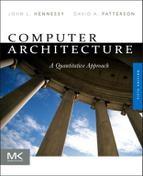Page references in bold represent figures and tables.
A
Access bit
IA-32 descriptor table, B-52
Access time See also Average Memory Access Time (AMAT)
vs. block size, B-28
distributed-memory multiprocessor, 348
memory hierarchy basics, 77
NUMA, 348
paging, B-43
slowdown causes, B-3
TLP workloads, 369–370
during write, B-45
WSC memory hierarchy, 444
Active low power modes, WSCs, 472
Address Coalescing Unit
function, 310
gather-scatter, 329
GPUs, 300
Multithreaded SIMD Processor block diagram, 294
vector processor, 310
Address fault, virtual memory definition, B-42
Addressing modes
comparison, A-11
compiler writing-architecture relationship, A-30
control flow instructions, A-17 to A-18
displacement mode, A-10
instruction set encoding, A-21
MIPS data transfers, A-34
selection, A-9
Address offset, virtual memory, B-56
Address space
Fermi GPU architecture, 306–307
Multimedia SIMD vs. GPUs, 312
SMP/DSM shared memory, 348
virtual memory, B-40 to B-41
Address trace, cache performance, B-4
Address translation
AMD64 paged virtual memory, B-55 to B-56
during indexing, B-36 to B-40
memory hierarchy basics, 77–78
Opteron data TLB, B-47
virtual memory, B-46
virtual memory definition, B-42
virtual memory protection, 106
Administrative costs, WSC vs. datacenters, 455
Advanced Research Project Agency See ARPA (Advanced Research Project Agency)
Advanced RISC Machine See ARM (Advanced RISC Machine)
Advanced Technology Attachment disks See ATA (Advanced Technology Attachment) disks
Affine, loop-level parallelism dependences, 318–320, H-6
Airside econimization, WSC cooling systems, 449
Akamai, as Content Delivery Network, 460
ALAT See Advanced load address table (ALAT)
Aliased variables, and compiler technology, A-27 to A-28
Aliases, address translation, B-38
ALUs See Arithmetic-logical units (ALUs)
AMAT See Average Memory Access Time (AMAT)
Amazon Elastic Computer Cloud (EC2), 456–457
MapReduce cost calculations, 458–459
price and characteristics, 458
Amazon Simple Storage Service (S3), 456–457
Amazon Web Services (AWS)
cloud computing providers, 471–472
as utility computing, 456–461
WSC cost-performance, 474
Xen VM, 111
Amdahl’s law
computer design principles, 46–48
computer system power consumption case study, 63–64
DRAM, 99
and parallel computers, 406–407
parallel processing calculations, 349–350
pitfalls, 55–56
vs. processor performance equation, 51
scalar performance, 331
WSC processor cost-performance, 472–473
AMD Barcelona microprocessor, Google WSC server, 467
AMD Opteron
address translation, B-38
Amazon Web Services, 457
architecture, 15
cache coherence, 361
Google WSC servers, 468–469
inclusion, 398
manufacturing cost, 62
misses per instruction, B-15
MOESI protocol, 362
multicore processor performance, 400–401
multilevel exclusion, B-35
paged virtual memory example, B-54 to B-57
vs. Pentium protection, B-57
real-world server considerations, 52–55
server energy savings, 25
snooping limitations, 363–364
SPEC benchmarks, 43
TLB during address translation, B-47
AMD processors
architecture flaws vs. success, A-45
shared-memory multiprogramming workload, 378
terminology, 313–315
tournament predictors, 164
Virtual Machines, 110
VMMs, 129
AMPS See Advanced mobile phone service (AMPS)
Android OS, 324
Antialiasing, address translation, B-38
Apogee Software, A-44
Application binary interface (ABI), control flow instructions, A-20
Architect-compiler writer relationship, A-29 to A-30
Architecturally visible registers, register renaming vs. ROB, 208–209
Architecture See also Computer architecture See also CUDA (Compute Unified Device Architecture) See also Instruction set architecture (ISA) See also Vector architectures
compiler writer-architect relationship, A-29 to A-30
definition, 15
heterogeneous, 262
Arithmetic/logical instructions
VAX, B-73
Arithmetic-logical units (ALUs)
basic MIPS pipeline, C-36
branch condition evaluation, A-19
data forwarding, C-40 to C-41
data hazards requiring stalls, C-19 to C-20
data hazard stall minimization, C-17 to C-19
effective address cycle, C-6
hardware-based execution, 185
immediate operands, A-12
Intel Core i7, 238
ISA operands, A-4 to A-5
ISA performance and efficiency prediction, 241
load interlocks, C-39
microarchitectural techniques case study, 253
MIPS pipeline control, C-38 to C-39
MIPS pipeline FP operations, C-52 to C-53
MIPS R4000, C-65
operand forwarding, C-19
operands per instruction example, A-6
parallelism, 45
pipeline branch issues, C-39 to C-41
pipeline execution rate, C-10 to C-11
power/DLP issues, 322
RISC classic pipeline, C-7
RISC instruction set, C-4
simple MIPS implementation, C-31 to C-33
ARM (Advanced RISC Machine)
control flow instructions, 14
ISA class, 11
memory addressing, 11
operands, 12
ARM Cortex-A8
dynamic scheduling, 170
ILP concepts, 148
instruction decode, 234
ISA performance and efficiency prediction, 241–243
memory access penalty, 117
memory performance, 115–117
multibanked caches, 86
overview, 233
pipeline structure, 232
processor comparison, 242
way prediction, 81
Arrays
access age, 91
blocking, 89–90
cluster server outage/anomaly statistics, 435
examples, 90
Google WSC servers, 469
Layer 3 network linkage, 445
loop interchange, 88–89
loop-level parallelism dependences, 318–319
WSC memory hierarchy, 445
WSCs, 443
Array switch, WSCs, 443–444
Assembly language, 2
Associativity See also Set associativity
cloud computing, 460–461
loop-level parallelism, 322
multilevel inclusion, 398
Opteron data cache, B-14
shared-memory multiprocessors, 368
Asynchronous events, exception requirements, C-44 to C-45
ATA (Advanced Technology Attachment) disks
server energy savings, 25
ATM See Asynchronous Transfer Mode (ATM)
Atomicity-consistency-isolation-durability (ACID), vs. WSC storage, 439
Attributes field, IA-32 descriptor table, B-52
Availability
data on Internet, 344
fault detection, 57–58
loop-level parallelism, 217–218
mainstream computing classes, 5
modules, 34
open-source software, 457
RAID systems, 60
as server characteristic, 7
servers, 16
source operands, C-74
Average Memory Access Time (AMAT)
block size calculations, B-26 to B-28
cache performance, B-16 to B-21
calculation, B-16 to B-17
centralized shared-memory architectures, 351–352
definition, B-30 to B-31
memory hierarchy basics, 75–76
miss penalty reduction, B-32
as processor performance predictor, B-17 to B-20
AVX See Advanced Vector Extensions (AVX)
AWS See Amazon Web Services (AWS)
..................Content has been hidden....................
You can't read the all page of ebook, please click here login for view all page.
